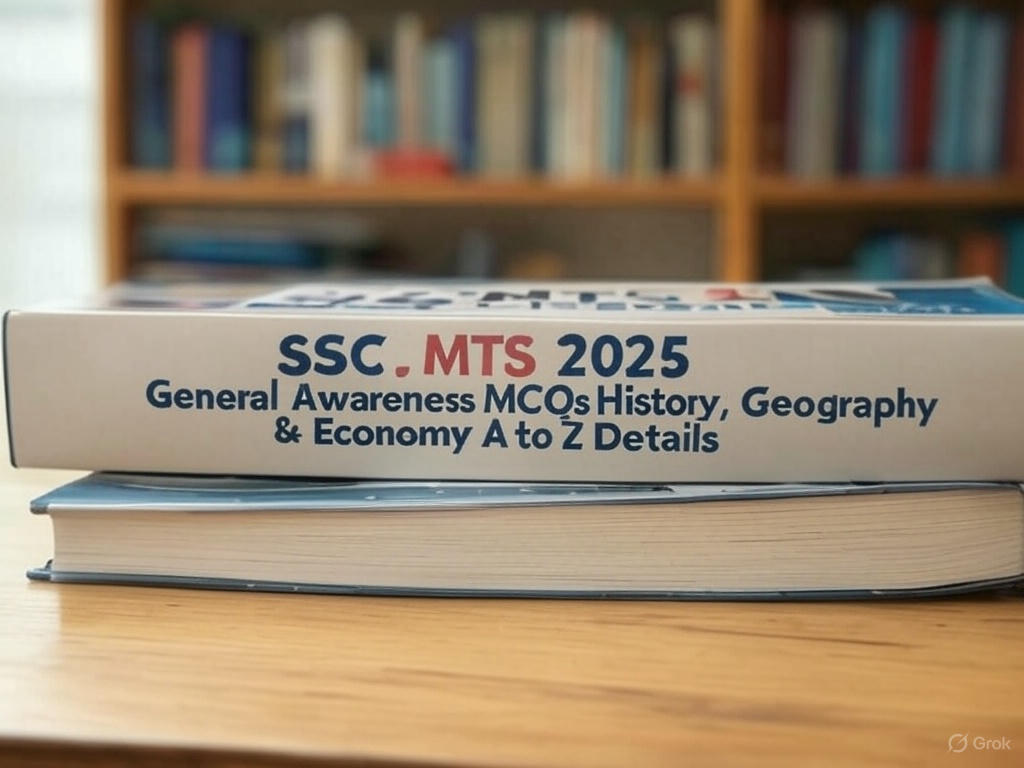SSC MTS 2025 General Awareness: History, Geography, and Economy – A to Z Details
A – About the Section
The General Awareness section in SSC MTS Paper 1 (Session II) consists of 25 questions worth 75 marks (3 marks each), with a 1-mark penalty for incorrect answers. It tests knowledge of History (Ancient, Medieval, Modern India), Geography (Physical, Indian, World), Economy (Basic concepts, Indian economy, current developments), and other areas like Polity, Science, and Current Affairs.
B – Basics to Know
- History: Key events, rulers, movements (e.g., Indus Valley, Mughal Empire, Freedom Struggle).
- Geography: Physical features, climate, resources (e.g., rivers, mountains, monsoons).
- Economy: Fundamental terms (GDP, inflation), government schemes, budgets.
C – Coverage
Covers static GK (facts) and dynamic GK (recent events up to early 2025). Expect 4-6 questions each from History, Geography, and Economy.
D – Difficulty Level
Typically easy to moderate, based on Class 10-level knowledge, with some current affairs-based twists.
E – Exam Pattern
- Session II: General Awareness (25 questions) + English Language (25 questions).
- Time: 45 minutes.
- Negative Marking: 1 mark deducted per wrong answer.
F – Focus Areas
- History: Freedom Movement, major dynasties.
- Geography: Indian physical geography, world superlatives.
- Economy: Budget 2025-26, economic policies.
G – General Tips
- Read newspapers (e.g., The Hindu) for current economic and geographic events.
- Use NCERT books (Class 6-10) for static knowledge.
H – History MCQs (Sample)
- Question: Who was the founder of the Maurya Empire?
- A) Ashoka
- B) Chandragupta Maurya
- C) Bindusara
- D) Samudragupta
- Answer: B) Chandragupta Maurya
- Explanation: Founded in 321 BCE, Chandragupta Maurya established the Maurya Empire with Chanakya’s help.
- Question: The Quit India Movement was launched in which year?
- A) 1940
- B) 1942
- C) 1945
- D) 1947
- Answer: B) 1942
- Explanation: Launched on August 8, 1942, by Mahatma Gandhi during World War II.
I – Importance
General Awareness can be a scoring section if prepared well, as it requires less calculation and more recall.
J – Justify Preparation
Frequent repetition of topics (e.g., Indus Valley sites, major rivers, GDP concepts) makes it predictable.
K – Key Topics
- History: Indus Valley, Vedic Age, Mughal Era, 1857 Revolt, Independence.
- Geography: Monsoons, Himalayan ranges, soil types.
- Economy: Five-Year Plans, RBI functions, taxes.
L – Learning Resources
- NCERT History (6-12), Geography (6-11), Economy (9-12).
- Lucent’s General Knowledge.
- Monthly current affairs magazines (up to March 2025).
M – MCQs (Geography Sample)
- Question: Which river is known as the “Sorrow of Bihar”?
- A) Ganga
- B) Kosi
- C) Yamuna
- D) Brahmaputra
- Answer: B) Kosi
- Explanation: The Kosi River frequently floods, causing devastation in Bihar.
- Question: The Tropic of Cancer does NOT pass through which state?
- A) Rajasthan
- B) Madhya Pradesh
- C) Kerala
- D) Gujarat
- Answer: C) Kerala
- Explanation: Kerala lies south of the Tropic of Cancer (23.5°N).
N – Negative Marking
Answer only if confident, as 1-mark deduction impacts scores significantly.
O – Objective
Tests awareness of surroundings, historical context, and economic basics relevant to India.
P – Preparation Strategy
- Daily 30-minute GK revision.
- Practice 20-30 MCQs daily from past papers.
Q – Quick Facts
- History: First War of Independence – 1857.
- Geography: Longest river in India – Ganga (2,525 km).
- Economy: India’s GDP growth (2024 est.) – ~6-7% (per recent projections).
R – Relevance
Questions often link to India and neighboring countries, e.g., SAARC economies, Himalayan geography.
S – Sample Economy MCQs
- Question: Who presents the Union Budget in India?
- A) Prime Minister
- B) Finance Minister
- C) President
- D) RBI Governor
- Answer: B) Finance Minister
- Explanation: The Finance Minister (e.g., Nirmala Sitharaman in 2025) presents the budget annually.
- Question: GST was implemented in India on?
- A) July 1, 2016
- B) July 1, 2017
- C) April 1, 2018
- D) January 1, 2019
- Answer: B) July 1, 2017
- Explanation: Goods and Services Tax unified indirect taxes in India.
T – Time Management
Spend ~1 minute per question; skip doubtful ones to avoid negative marking.
U – Updates (2025)
Focus on Budget 2025-26 (likely February 2025), new economic policies, and geographic events (e.g., natural disasters).
V – Variety
Expect mixed questions, e.g., “Which dynasty built the Red Fort?” (Mughal) or “Which state has the longest coastline?” (Gujarat).
W – Weightage
- History: 4-6 questions.
- Geography: 4-5 questions.
- Economy: 3-5 questions.
X – X-Factor
Current affairs (e.g., economic reforms in 2024-25) can give an edge.
Y – Yearly Trends
Past papers (2021-2024) show recurring themes like Gandhi’s movements, river systems, and inflation.
Z – Zero Errors
Revise facts (e.g., dates, capitals) to minimize silly mistakes.
Additional Table: Topic-Wise Breakdown
| Subject | Key Topics | Expected Questions | Sample Focus |
|---|---|---|---|
| History | Ancient (Harappa), Medieval (Mughals), Modern (Freedom Struggle) | 4-6 | 1857 Revolt, Ashoka’s Edicts |
| Geography | Physical (Rivers, Mountains), Human (Population), World GK | 4-5 | Monsoons, Himalayan States |
| Economy | Basic Terms, Budget, Schemes, Banking | 3-5 | GST, RBI Role, Five-Year Plans |
How to Use This
- Practice: Solve 50+ MCQs weekly from each subject.
- Revise: Focus on weak areas (e.g., Medieval History, Economic Terms).
- Mock Tests: Simulate Session II conditions (45 mins, 50 questions).
